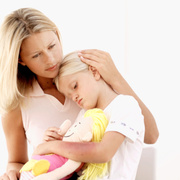 Stockbyte/Thinkstock
Stockbyte/Thinkstock
Each year in the United States, about 3 percent of children will have a urinary tract infection, accounting for more than 1 million health care visits, according to the National Kidney and Urologic Diseases Information Clearinghouse.
A urinary tract infection occurs when bacteria make their way into the urethra. From there, it can reach the bladder. An infection in the bladder may spread to the kidneys.
However, most urinary tract infections in children affect the bladder, noted MedlinePlus.
Girls have a higher risk of developing a urinary tract infection than boys. The lifetime risk of a urinary tract infection for a girl is 8 percent, while it is 2 percent for a boy, noted the National Kidney and Urologic Diseases Information Clearinghouse. However, uncircumcised boys under the age of six months have a greater risk, compared to circumcised boys of the same age.
Certain medical conditions can make it more likely for a child to develop a urinary tract infection.
For example, disorders such as hydrocephalus, myelomeningocele and spinal cord injury can make it more difficult for a child to empty her bladder. Vesicoureteral reflux is a disorder that affects the urinary tract, resulting in urine flowing back to the kidneys.
Hygiene and lifestyle choices may also result in a urinary tract infection. This can include not urinating enough during the day and wiping from back to front after using the bathroom.
For girls, wearing tight-fitting clothing and taking bubble baths may increase their risk for a urinary tract infection, according to MedlinePlus.
Children who have a urinary tract infection may not have any symptoms, or they may have a fever, vomiting and a poor appetite. If the infection involves the bladder, symptoms may include pain with urination, cloudy urine, foul smelling urine and blood in the urine.
Children may also feel ill, have a urgent need to urinate, and may have wetting problems. If the infection spreads to the kidneys, symptoms may include fever, vomiting, severe abdominal pain, flushed skin, side or back pain, nausea and chills with shaking.
A urinary tract infection in children is treated with antibiotics, such as amoxicillin. Administration will vary by age.
Younger infants will be given antibiotics intravenously, while older infants and children will be given antibiotics orally. Children who have recurrent urinary tract infections or those who have vesicoureteral reflux may be on antibiotics for six months to two years.
References
MedlinePlus Medical Encyclopedia. Urinary Tract Infection – Children. Web. 11 June 2012
http://www.nlm.nih.gov/medlineplus/ency/article/000505.htm
National Kidney and Urologic Diseases Information Clearinghouse. Urinary Tract Infections in Children. Web. 11 June 2012
http://kidney.niddk.nih.gov/kudiseases/pubs/utichildren
Reviewed June 11, 2012
by Michele Blacksberg RN
Edited by Jody Smith




Add a Comment1 Comments
The actual number one cause of urinary tract infection is accumulated rectal stool as proven in the late 60's and then reinforced by Sean O'Regan in the 80's. The misconceptions in this article are common, but that doesn't make them any less troubling.
July 10, 2012 - 7:53amThis Comment